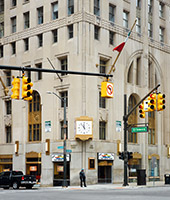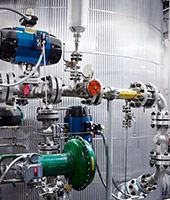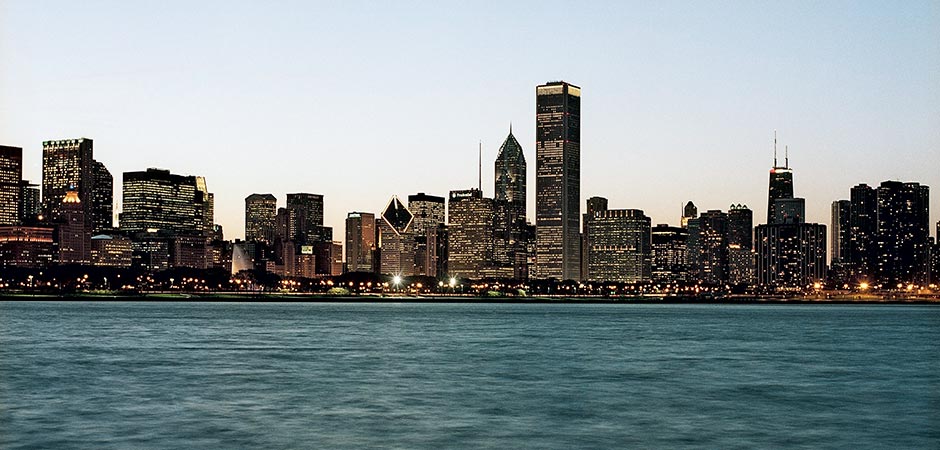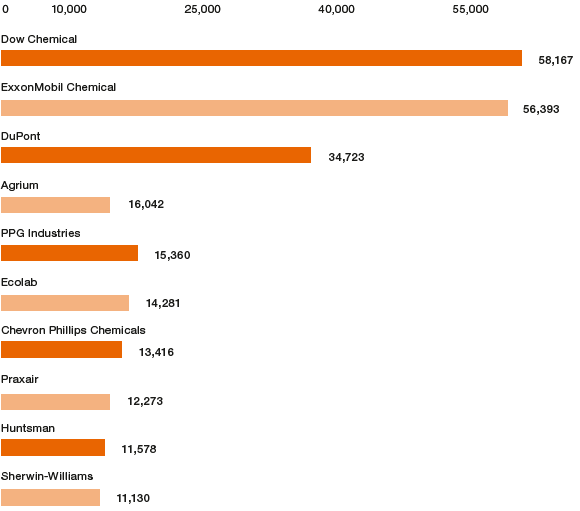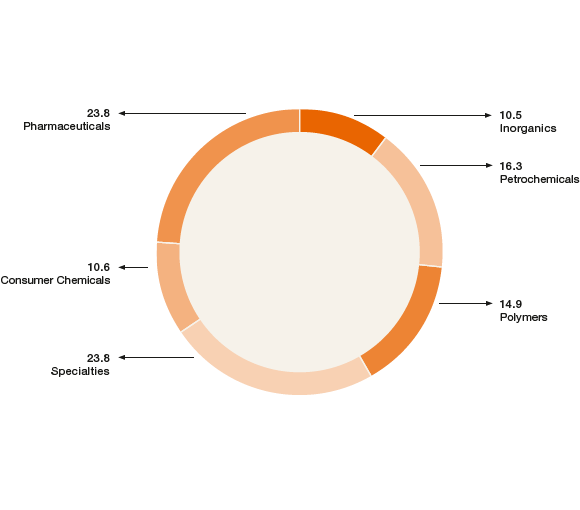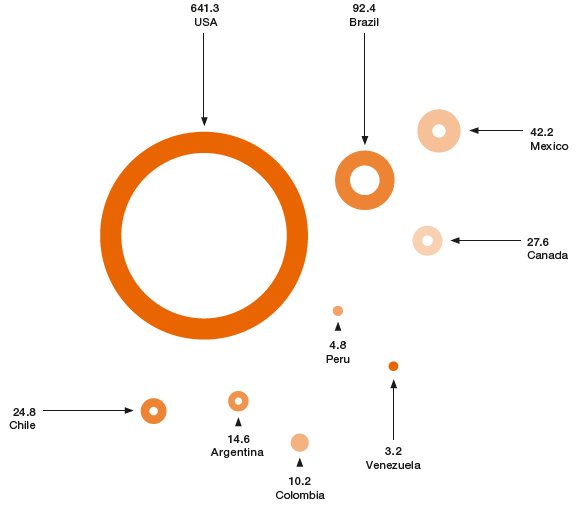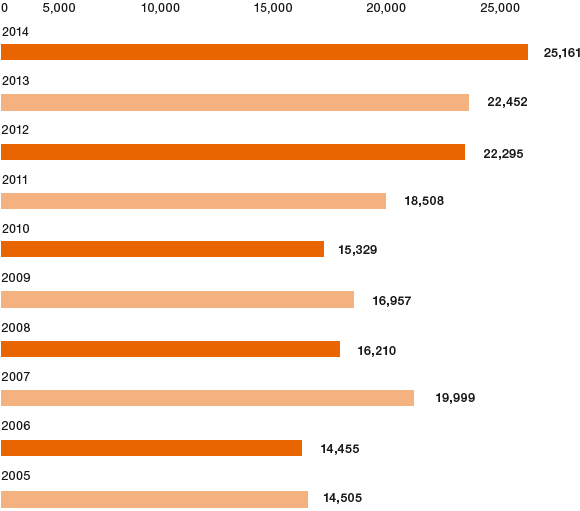USA – The World’s Second-Largest Chemical Market
Thanks to the boom in shale gas, the US chemical market in particular has been undergoing a renaissance since 2009. Over the past few years, annual chemical production in the Americas has risen by 3.6 percent on average. Investments have climbed 10 percent during the same period. The chemical industry on the other side of the Atlantic is dominated by two countries. The US chemical sector accounts for 90 percent of chemical sales in North America. The main player in South America is Brazil, which represents 51 percent of chemical sales there.
WACKER first entered the North American chemical market when it established a subsidiary in New York in 1965. In 1969, we acquired a stake in Stauffer Chemicals Corporation in Adrian, Michigan, which remains our base for coordinating our silicones business in the Americas. Now, 46 years later, a new era dawns for WACKER – because by commissioning the Charleston plant (Tennessee), the foundations are being laid for our first fully integrated production site in the Americas.
The Americas

The World’s Second-Largest Chemical Market
Thanks to the boom in shale gas, the US chemical market in particular has been undergoing a renaissance since 2009. Over the past few years, annual chemical production in the Americas has risen by 3.6 percent on average. Investments have climbed 10 percent during the same period. The chemical industry on the other side of the Atlantic is dominated by two countries. The US chemical sector accounts for 90 percent of chemical sales in North America. The main player in South America is Brazil, which represents 51 percent of chemical sales there.
WACKER first entered the North American chemical market when it established a subsidiary in New York in 1965. In 1969, we acquired a stake in Stauffer Chemicals Corporation in Adrian, Michigan, which remains our base for coordinating our silicones business in the Americas. Now, 46 years later, a new era dawns for WACKER – because by commissioning the Charleston plant (Tennessee), the foundations are being laid for our first fully integrated production site in the Americas.
States
50
Population
321.4 million
LAND Area
9,826,675 km2
The American Dream
From rags to riches: Rose Blumkin was among those who embodied the American dream. This petite lady may only have been 1.47 meters tall, but she was “a business giant,” according to business magnate Warren Buffett. She arrived in Omaha, Nebraska, as a poor immigrant from Minsk in present-day Belarus. In the 1930s, this young woman used a loan of US$ 500 to open a tiny furniture store. With her seven-day week and “Sell cheap and tell the truth” motto, she turned her store into the largest of its kind in America over the decades to come. Warren Buffet eventually purchased her “Nebraska Furniture Mart” – for US$ 1 billion.
Rose Blumkin was a passionate saleswoman, who stayed loyal to the company throughout, driving around the vast shop premises in her motorized cart and continuing to advise customers until her death in 1998 at the ripe old age of 104. Warren Buffett opened huge new branches of her store, the most recent near Dallas in May 2015. The sheer size of the store was “a shock,” marveled The Economist. A 2,300-strong workforce sells furniture, mattresses, carpets, floor coverings, gardening and baby articles, computers and other electronic devices over a retail space the size of ten American football fields. Every day, 70 delivery trucks arrive, and 20,000 shoppers descend each Saturday. Warren Buffet expects sales to reach US$ 1 billion during his first year.
The Largest Domestic Market in the World
“Think big.” The same phrase applies to the whole of this vast country as well as to its high-spending inhabitants. The USA is 25 times the size of Germany and has 321 million inhabitants. That’s only about 4.5 percent of the world’s population, but they account for an astonishing 20 percent of the world’s total economic output. While the European Union argued about the distribution of 160,000 refugees in 2015, a million new arrivals to the USA get their Green Card every year. They help to create the world’s largest domestic market: every year, American consumer spending amounts to US$ 12 trillion – more than China spent in total even during its best boom years. The US economy grew by some 2.5 percent in 2014 and again in 2015. That’s a whole percentage point more than in the European Union. Job growth was higher in 2014 than at any other time since the turn of the new millennium, with some 260,000 new jobs being created every month. This trend, despite tailing off slightly, continued in 2015. As a result, unemployment in October fell to 5 percent – the last time it was this low was back in 2008 before the labor market was hit by the financial crisis. Germany’s economic development agency GTAI (Germany Trade and Invest) gave the following assessment: “In the summer of 2015, there was still no end in sight to the economic upswing that had started over six years ago.” With the BRICS flagging, America has become the main engine for global growth.
The US – an Attractive Market for German Exports
As the world’s largest market for imported goods, the USA has become even more attractive and important, especially for Germany’s export-driven economy. In 2014, the US trade balance closed with a deficit of US$ 505 billion – roughly equivalent to the total gross domestic product of Bavaria. The USA’s biggest trade deficit is with China, while its second largest is with Germany: what the USA imported was worth US$ 73.7 billion more than its exports. After more than fifty years, the USA replaced France as Germany’s major trading partner in 2014.
A Consumer-Friendly Environment
Alongside the strong dollar, oil and gas price trends are the main reason for America’s importance to Germany. In 2014, the USA became the largest gas producer in the world, due to fracking and the exploitation of new shale deposits. At the same time, the price of crude oil fell over nine months from 110 dollars to below 60 dollars at the start of 2015. In September, the price of gasoline reached an eleven-year low. In December 2015, the price of crude oil fell to around 30 dollars. The money that people now save at the gas station can be spent on consumer goods instead: in 2015, US disposable income rose an average 4.8 percent.
As a result, some 18 million new cars were sold in 2015, the highest level of sales since 2000. The increased demand for cosmetics and anti-aging products shows the extent to which consumption, and hence the chemical industry, depend on social trends. Every day, some 10,000 Americans turn 65: the baby boomers are approaching retirement age.
Favorable Energy Prices – Reindustrialization
No end to this positive consumer spending is in sight, because, as BP boss Bob Dudley puts it, the price of oil is bound to stay low “for a few years yet.” This gives the USA further long-term opportunities. It’s no coincidence that the USA agreed to be this year’s partner country at the world’s largest industrial tradeshow in Hannover. In Germany, industry accounts for 31 percent of gross domestic product, but just 20 percent in the USA. That is set to change. “Our goal is to be among the world’s leading production centers once more,” says President Obama. This reindustrialization is in full swing. “Thanks to the gas boom, 400 new industrial projects have been launched,” says a delighted Ernest Moniz, US Secretary of Energy. Cheap gas gives the American chemical industry, in particular, “a crucial competitive edge,” underscores the American Chemistry Council (ACC), which estimates that US$ 153 billion have been invested in new facilities and capacity expansion. Of this amount, over half is due to investments by foreign companies. In a VCI survey, two-thirds of German chemical companies that invest in the USA mentioned the low production costs as the main reason.
Where Venture Capital Feels at Home
Low energy prices are not the only favorable factor: companies also often benefit from measures to promote business, such as the states’ willingness to provide roads and other infrastructure. What’s more, the pro-business and innovative mindset encountered in the USA is reflected by the considerable sums of money that private investors put into startups. Between 2011 and 2013, venture capital raised amounted to US$ 87 billion – thirty times more than in Germany. Most of it goes to California’s Silicon Valley, where tech companies continue to secure the country’s globally dominant position in the IT and internet sectors.
Benefiting from an Innovative Online Sector
The innovators based in California are meanwhile moving America’s policymakers toward innovation as well. The data centers run by the internet giants need huge amounts of electricity, to be generated from renewable sources in the future. For instance, Facebook announced it would be building its fifth computer center, to be supplied by a 200-MW wind farm. Google has set up a US$ 300-million fund for Solarcity, a company that makes photovoltaic modules. The idea is to use the money to help private homeowners switch over to solar modules.
Benefiting from Pioneering Industries
California’s internet and IT companies were among the first to join the American Business Act on Climate Pledge in support of President Obama’s efforts to reduce greenhouse gases. There are now over 80 such companies, employing nine million people in total. Coal-fired power stations are to be replaced by gas-fired power plants, wind power and solar installations. These companies are not just concerned with the environment; by setting company-specific climate targets, they also expect to cut costs, innovate and become more attractive to qualified workers.
Free Trade 1: TPP
Whether solar power installations, cars or anti-aging creams: the German chemical industry stands every chance of benefiting from trends, particularly if the Transatlantic Trade and Investment Partnership (TTIP) works out. Back in October 2015, the USA and eleven other Pacific Rim states agreed to create a new free-trade zone called TPP (Transpacific Partnership), which is expected to come into force in one to two years once national parliaments have given their approval. The agreement will dismantle trade barriers within a region accounting for 40 percent of the world’s trade volume.
Free Trade 2: How NAFTA Affects Mexico
Since its foundation in 1994, NAFTA – the North American Free Trade Agreement – has largely gone unnoticed in Germany. Yet it is thanks to NAFTA that America’s southern neighbor has become a key emerging market. Mexico is already the world’s 14th largest economy and also among the top ten oil-exporting countries. Industry, in particular, is strong in Mexico, and it’s no coincidence that BMW and Daimler-Benz announced the construction of new plants there in mid-2014. The country is the seventh largest automaker in the world, with 17 plants run by a total of nine international manufacturers. The economy is expected to grow by about 3 percent in 2016, just as it did in 2015. Growth is driven by exports, an astounding 80 percent of which head for the USA. “Investing activity, especially on the part of foreign companies, continues apace, because Mexico is becoming increasingly important as a production platform for North America,” says Germany Trade & Invest, which specializes in promoting German exports.
Free Trade 3: TTIP
While Mexico and the USA benefit from North American free trade, there is opposition in Europe to the planned transatlantic agreement. In October, some 150,000 demonstrators in Berlin expressed their fears about an erosion of environmental and consumer standards. These standards, though, are neither lower nor less strictly enforced in the USA, as shown by the EPA’s discovery of emissions tampering at VW. German Chancellor Angela Merkel regards the agreement as “a first step toward giving globalization an acceptable face.” Ultimately, TTIP aims not only at removing customs tariffs for the first time, but also at defining common product standards and test procedures.
TTIP would create the largest chemical-sector trading zone in the world. The USA and EU already account for some 35 percent of global trade in chemical products. It is to the USA, rather than to any single one of its European neighbors, that the German chemical industry sends most of its exports. In 2014, German companies sold goods worth € 16.5 billion to US customers – nearly 10 percent of the country’s total exports. According to the German Chemical Industry Association (VCI), TTIP would create some 2,000 new chemical-sector jobs in Germany, increasing product sales by € 2 billion and generating value added of € 600 million.
Outlook
Based on an American Chemical Council (ACC) survey, US chemical firms continue to be optimistic about the future. During the first nine months of 2014, US chemical-sector production grew 3.9 percent, i. e. much faster than the economy as a whole. Total chemical output in the USA rose 48 percent between 2004 and 2014. The ACC expects production to rise by almost another third in the period to 2019, reaching an annual value of over US$ 1 trillion.
Presence in USA Vital
Even without free-trade agreements, the degree to which the German and American chemical sectors are interlinked is already huge. It is important for major players on the US chemical market, which exports just one-fifth of its output, to operate their own local production plants. German subsidiaries in the USA number 130 and employ 70,000 people. In 2013, they generated sales of € 52 billion – over three times as much as the German chemical industry achieves in China, its second-largest base outside Germany.
